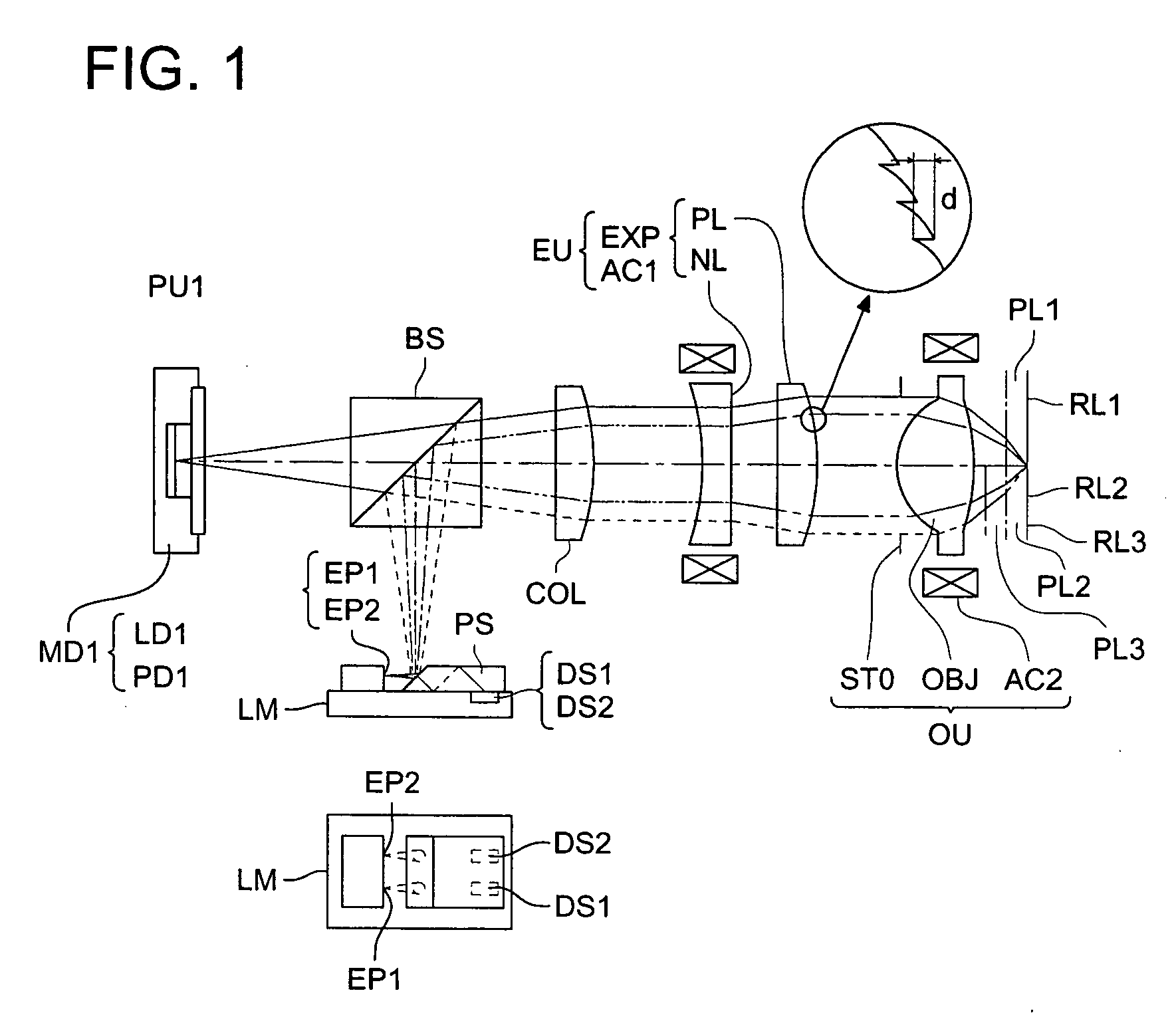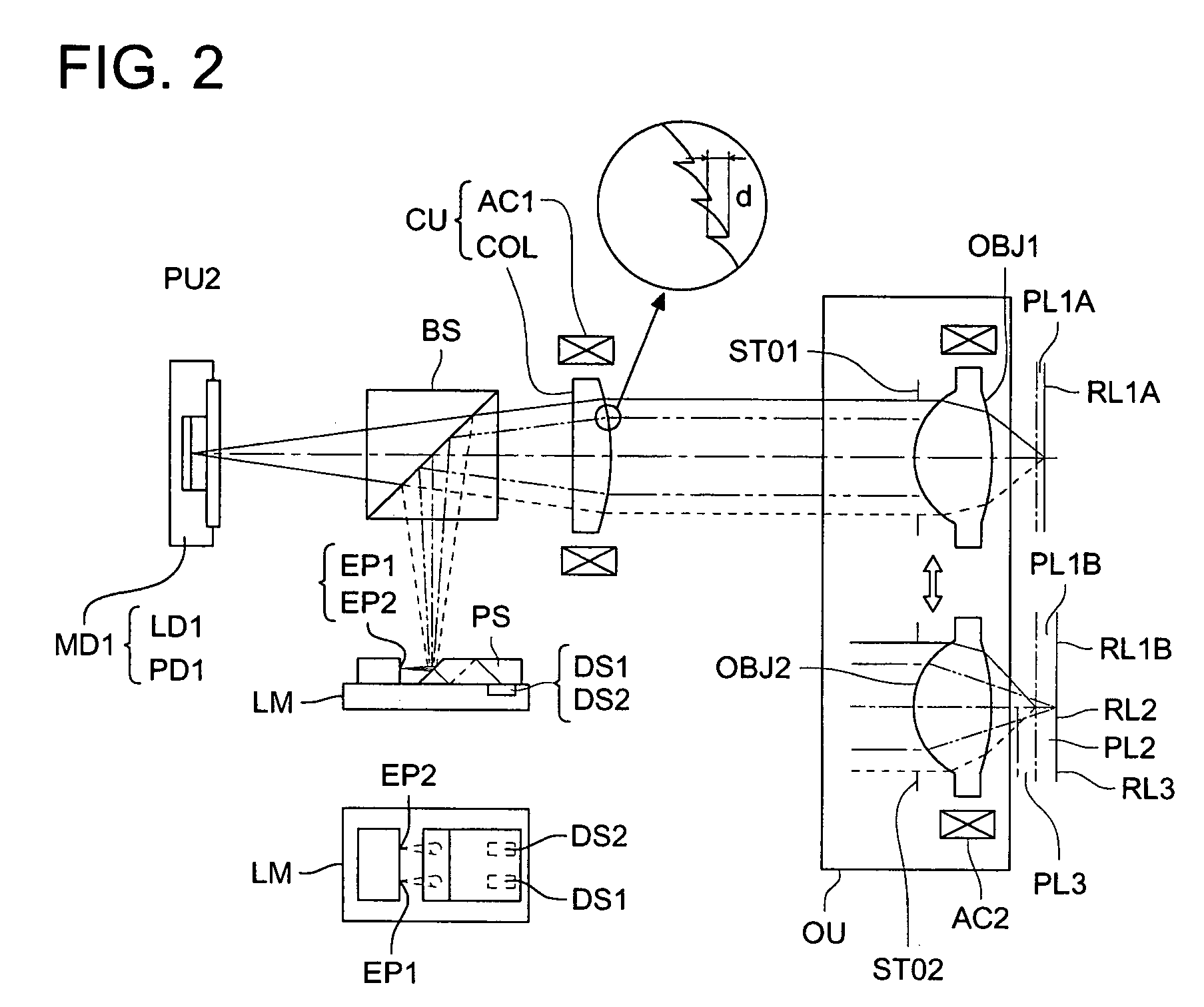Optical pickup device, optical information recording and reproducing apparatus, expander lens, coupling lens and chromatic aberration correcting optical element
a pickup device and optical element technology, applied in the direction of optical beam sources, door/window protective devices, instruments, etc., can solve the problems of insufficient value of optical disc player products, inability to conduct proper recording/reproducing of information for high density optical discs, and large focus error generation
- Summary
- Abstract
- Description
- Claims
- Application Information
AI Technical Summary
Problems solved by technology
Method used
Image
Examples
example 1
[0343] Example 1 is represented an optical system suitable as expander lens EXP and objective lens OBJ in optical pickup device PU1, and the optical system is composed of objective lens OBJ representing a plastic lens whose aberration correction is optimized for wavelength 405 nm and for a protective layer with a thickness 0.6 mm and of expander lens EXP composed of two plastic lenses including negative lens NL and positive lens PL.
[0344] Table 1 shows specific lens data of the optical system, FIG. 7 shows an optical path diagram for conducting recording / reproducing of information for high density optical disc HD, FIG. 8 shows an optical path diagram for conducting recording / reproducing of information for DVD and FIG. 9 shows an optical path diagram for conducting recording / reproducing of information for CD.
1TABLE 1 f1 = 2.308, NA1 = 0.65, .lambda.1 = 405 nm, m1 = 0.00, n1 = 10, d2 = 2.000, d6 = 1.059, d7 = 0.6 f2 = 2.385, NA2 = 0.63, .lambda.2 = 655 nm, m2 = -0.02, n2 = 6, d2 = 1.5...
example 2
[0353] Example 2 is represented by an optical system suitable as collimator lens COL, first objective lens OBJ1 and second objective lens OBJ2 in optical pickup device PU2, and the optical system is composed of first objective lens OBJ1 representing a plastic lens of a two-group two-element structure optimized in terms of aberration correction for wavelength 405 nm and a protective layer with thickness 0.1 mm, second objective lens OBJ2 representing a plastic lens optimized in terms of aberration correction for wavelength 405 nm and a protective layer with thickness 0.6 mm and of collimator lens COL representing a plastic lens.
[0354] Table 2 shows specific lens data of the optical system composed of first objective lens OBJ1 and collimator lens COL, Table 3 shows specific lens data of the optical system composed of second objective lens OBJ2 and collimator lens COL, FIG. 12 shows an optical path diagram for conducting recording / reproducing of information for the first high density o...
example 3
[0367] Example 3 is represented by an optical system suitable ad the first collimator lens COL1 and the first objective lens OBJ1, and it is composed of the first objective lens OBJ1 having interchangeablility for high density optical disc HD with standards of wavelength 405 nm, protective layer thickness 0.1 mm and numerical aperture 0.85 and for DVD with standards of wavelength 655 nm, protective layer thickness 0.6 mm and numerical aperature 0.65 and of the first collimator lens COL1 which is a plastic lens whose optical surface on the first objective lens OBJ1 side is made to be a differactive surface.
[0368] Table 4 shows specific lens data of this optical system, and FIG. 19 shows an optical path diagram.
4TABLE 4 f1 = 1.765, NA1 = 0.85, .lambda.1 = 405 nm, m1 = 0.00, n1 = 3, d0 = 19.034, d6 = 0.531, d7 = 0.1 f2 = 1.830, NA2 = 0.65, .lambda.2 = 655 nm, m2 = 0.00, n2 = 2, d0 = 24.445, d6 = 0.300, d7 = 0.6 Paraxial value Surface No. r (mm) d (mm) N.lambda.1 N.lambda.2 vd 0 --d0 --...
PUM
| Property | Measurement | Unit |
|---|---|---|
| first wavelength λ1 | aaaaa | aaaaa |
| wavelength | aaaaa | aaaaa |
| depth | aaaaa | aaaaa |
Abstract
Description
Claims
Application Information
 Login to View More
Login to View More - R&D
- Intellectual Property
- Life Sciences
- Materials
- Tech Scout
- Unparalleled Data Quality
- Higher Quality Content
- 60% Fewer Hallucinations
Browse by: Latest US Patents, China's latest patents, Technical Efficacy Thesaurus, Application Domain, Technology Topic, Popular Technical Reports.
© 2025 PatSnap. All rights reserved.Legal|Privacy policy|Modern Slavery Act Transparency Statement|Sitemap|About US| Contact US: help@patsnap.com



